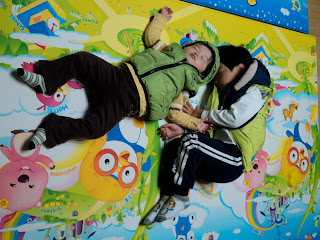In Ms Kim's Kitchen 8.30 pm
So, after we hauled the sleeping babies upstairs, Ms Kim showed me how to make a very popular, easy dish.
The only problem with the dish is that...um...well...it's made with squid. Like...all the squid. But, it's extremely popular and Sukheung loves this dish.
So, without further ado (or grossed-out comments from the peanut gallery--me) I present to you: How to Make Kimchee Chun. Just fyi: the pronunciation: kim-chE cha-Uhn
Step One: Thaw the squid.
Side note one: This means that Ms Kim regularly keeps squid (more than one) frozen squid in her refrigerator. yummy!
 |
| Ms Kim is laughing at me here. I had just asked her if that was squid. (Duh...) |
 |
| The Squid. All the squid... |
Side note two: Squid guts...enough said.
Step Three: cut the body into bit sized pieces. Place in medium sized bowl. Rinse the tentacles, place in bowl with body pieces.
Side note three: This, so far, is my problem with most food in Korea. The Squid tentacles. Yes, they eat them. And you can clearly see the tentacles in almost all the food dishes.
 |
| Just in case you needed a close up. |
Side note four: Left-over Kimchee--also enough said. This is the national dish of South Korea, and while I actually don't mind it, it is quiet a bit sour and spicy. For Koreans to just have it lying around in their fridge makes some people cringe.
 |
| Kimchee |
Side note five: For the Dankert family: Remember when we had those cabbage pancakes that the Japanese exchange students made? Yah...this is another kind of pancake. Once I realized that it was another pancake, I started to prepare myself.
Step six: Mix
Side note six: Look at the picture...is a side note necessary? No.
This is 4 or 5 servings of Kimchee Chun. Ms Kim puts it in a tupperware so that she can just have it ready for SukHeung's dinner.
Step Seven: Heat a skillet and pour a small amount of mixture into the pan. Flatten the mixture out so that everything is able to be heated/cooked. About 5-6 minutes on each side
Side note seven: Squid and Kimchee pancake. Yummy...
Step Eight: Enjoy!
Side note eight: Enjoy? ... Really?
Ms Kim stole my camera, which was laying out on the kitchen table after taking pictures of the sleeping boys, and took this shot of me as I sampled the kimchee chun. I couldn't really not try it, she had shown me step by step how to make this food. It was a great bonding moment for us. And I mean, maybe it tasted better than it looked. One could always hope.
 |
| I think the face says it all. One could hope, but don't expect much from Kimchee and squid. |
Interesting fact: I basically was raising (talking about Asian food here) with the knowledge that Asians used only chopsticks. I studied Japanese culture for a long time and know a lot about the intricacies and eating etiquette of using chopsticks. The I come to Korea and BAM! I now have a spoon. I didn't know that other Asian cultures used different eating utensils. But Korean food is different. They have two main dishes every meal: Rice and a soup. Every meal is served with rice and soup. So you have a spoon. Rice and soup are both eaten with the spoon. Then you use the chopsticks to eat the side dishes (that are always served with a meal). At lunch on Wednesday, I was eating the rice with the chopsticks and was corrected. Eat Rice and soup with the spoon, then change to chopsticks and eat the kimchee and other side dishes. Kimchee is served with every meal (being that it is the national food).
I've gotten better at the chopsticks too. Chopsticks in Korea are different than in Japan. Its like regional variations on spearheads for Native Americans. An expert can date spearheads by tribe and style based on their shape. Well, in Asia, it might be similar. Japanese chopsticks are round and made of wood. Korean chopsticks are flat and made of metal. This really perplexed me on Monday because they are slippery and I made a goof of myself during lunch. I had the dexterity of a child. But by the end of the week, I can at least grab food (and hold on to it) to get it in my mouth. Hopefully, I'll continue to get better.







No comments:
Post a Comment